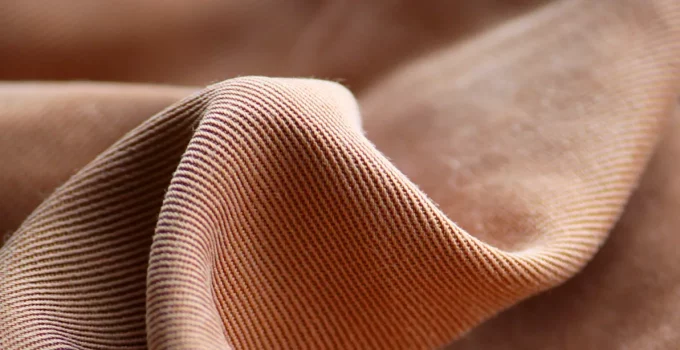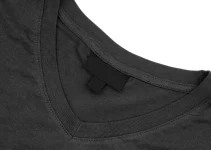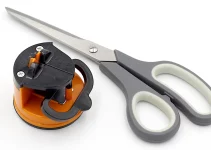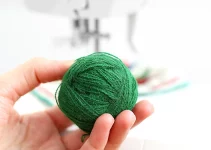If we were to just quickly answer the question is rayon stretchy, we would simply say that rayon is not stretchy because there’s no elasticity in its fibers. In fact, we should also say that rayon has a very low elastic recovery. It’s the same for percale or plain weave fabrics.
However, I want to do more than offer a simple answer stating that rayon is not a stretchy material. I want to see if we can stretch rayon, what is this material made from and if it’s something we should work with for our projects in making clothes or anything else.
By the way, if what you’re looking for is stretchy fabrics, you should focus on: spandex/lycra (the most stretchy), nylon, knits, neoprene.
In the world of making clothes and more, most fabrics fall into 2 categories:
- natural fabrics: silk (derived from larvae), wool (comes from sheep), linen (stems of flax plants), cotton (cotton plants)
- synthetic fabrics (man-made fabrics): spandex/elastane, neoprene (for making wetsuits), nylon, microfiber, polyester (fleece), etc.
Another thing we can mention about these two fabric categories is that natural fabrics are generally not stretchy.
If we want stretchy fabrics, we need to look at synthetic fabrics. Synthetic fibers can also be combined with natural fibers to result in a more stretchy fabric that becomes a natural-synthetic fabric. Thus, we obtain fiber blends and combinations.
Those few fabrics that don’t belong to either synthetic or natural fabrics are called semi-synthetic.
What Is Viscose Rayon?

You might have seen that rayon, also known as viscose, doesn’t belong to any of these two categories. It’s not because I forgot about it. It’s because it falls in between natural and synthetic fabrics. It doesn’t belong wholly to either of the two.
However, if you were to read this article, you would find that, according to them, rayon is a synthetic fiber.
Nevertheless, I consider that rayon falls into the category of semi-synthetic fabrics. That’s because the definition for semi-synthetic fabrics is: fibers that are made from natural raw materials that are only modified or partially degraded by chemical processes.
Most semi-synthetic fibers are cellulose regenerated fibers.
Rayon (viscose) is the earliest known semi-synthetic fabric.
It was produced as a substitute for silk and it does have a soft and smooth, sometimes even silky texture.
It’s also shiny, it can have a sheen ranging from low sheen to a very shiny texture. It resembles cotton in some of its characteristics but rayon is more drapey and shiny.
Therefore, rayon is a semi-synthetic fiber made from natural materials (wood pulp) that undergo intense chemical processing. The materials are natural but the intense chemical processing of these natural fibers transforms rayon into a semi-synthetic.
Most semi-synthetic fabrics are cellulose regenerated fibers. That means that cellulose fibers are regenerated from natural cellulose:
- wood pulp (rayon)
- beech trees (modal)
- bamboo grass (bamboo viscose)
- seaweed (seacell)
And the answer to the question is rayon stretchy still remains no, it’s not.
Is Viscose Rayon Stretchy?
We’ve already established that rayon is made from wood pulp, which would classify it as a natural fabric. However, due to the intense chemical processing it undergoes, it’s actually classified as a semi-synthetic.
Another thing we should know is that, among other fabrics, rayon is less elastic. And that’s why I said that rayon is not stretchy.
If you are interested in knowing how to take care of viscose rayon clothes, check out my article answering the question what is a cool iron.
Rayon shrinks
On the other hand, according to this article, there’s another thing we should know: if rayon shrinks.
We’re actually told that rayon can shrink due to overheating when it’s washed and dried or ironed.
It’s good to know that, if we avoid overheating during washing or dry cleaning or if we avoid excessive heat iron, then rayon will keep its shape and initial dimensions.
Air drying is preferred. And washing in cold water, preferably by hand.
Most rayon garments can’t handle machine-washing so we’re stuck with hand-washing if we want to avoid any shrinking.
Is rayon stretchy in jeans?
As long as the jeans contain rayon, cotton and spandex, then we get stretchy jeans.
Skinny jeans contain spandex, those are the fibers that make them stretchy. Rayon has no contribution to stretchiness.
Rayon fibers are used in jeans to make them sturdy and to keep them from stretching too much over time. It’s the opposite of spandex.
Cotton can expand and get saggy with lots of wear, while rayon fabric maintains its shape even with lots of wear. It’s tough and durable.
Can We Stretch Rayon?
Since we’ve already said that, generally, rayon is not stretchy, I want to see which are the exceptions. Are there any special conditions in which rayon can stretch?
One of the most important characteristics of rayon is that it’s moisture-absorbent. It is in fact more absorbent than cotton. That’s a major reason for which rayon is used as a perfect fabric for activewear and humid climates.
It absorbs moisture from the skin so we tend to wear clothes made from this semi-synthetic fabric during the summer months. Moreover, it’s also breathable and it doesn’t retain heat. That’s another reason for using it to make fitness attire or clothes for the summer.
However, I mentioned that it’s moisture-absorbent for a second reason.
When rayon absorbs moisture from the air, it can become longer. Thus, high humidity can make rayon longer. When there is less humidity, it returns to its normal length.
However, just because rayon can become longer during high humidity that still doesn’t make it a stretchy fabric.
How Viscose Rayon Is Stretched (fabric blends)
Well, in order to make a non-stretchy fabric to stretch, we must combine it with stretchy fibers. It sounds pretty logical, doesn’t it?
However, the fibers must be knitted in order to have stretch characteristics. If the fibers are woven, there will be almost no stretch.
One way to make rayon stretchy is to combine the cellulose regenerated fibers with lycra/spandex. Rayon-spandex blends can have a 4-way stretch, being capable of both horizontal and vertical stretch.
Thus, one sure way to add more stretch and recovery to the fabric, to make it more versatile and practical, is to combine rayon with spandex/lycra. We can get a blend of 95% rayon and 5% spandex.
Rayon jersey knits is a blend that has a fair amount of stretch. It’s used for summer dresses, tops, skirts, blouses and leisurewear.
On the other hand, double rayon jersey knits are less elastic and heavyweight. This fabric blend is used for pants and jackets because it doesn’t crease.
How to Unshrink Rayon Fabric
Besides establishing that rayon is not stretchy, having a very low elastic recovery, we also established that rayon fabric can shrink if it’s not washed and dried properly (cold water, air dry) or under excessive heat iron.
However, we also found out that high humidity can make it lengthen.
Given these two basic facts, let’s see which are the ways in which we can unshrink rayon.
You will need:
- baby shampoo or hair conditioner
- large bowl
- line or hanger
Step 1
Add 1 tablespoon baby shampoo or hair conditioner to 1 quart water. If you have a big garment, use more water and baby shampoo or hair conditioner.
The quantity of water should be big enough to fully submerge the garment you’re trying to unshrink.
This solution is supposed to relax the fibers of the shrunken rayon.
However, you should also keep in mind that it’s harder to stretch rayon than cotton or wool because it’s a semi-synthetic fabric, while cotton and wool are natural fabrics that have looser weaves.
Step 2
Place your rayon garment into the water.
Let it soak for a few minutes.
After, remove it from the water and gently squeeze out excess water.
Step 3
Stretch out the garment back to its original shape and size.
If you find that the fabric is too stiff, you need to use a steamer or the steam from an iron to make it softer.
Hang it on a line or hanger to air dry.
Continue to stretch it while it’s drying to ensure that it stays that way when it’s dry.
You can also secure the edges with clothespins or heavy objects.
Step 4
If the garment still isn’t in the original shape, steam it once it’s dry. Stretch it out gently.
Three Main Types of Rayon
There are three main types of rayon used in the clothing industry: viscose rayon, lyocell and modal.
Viscose rayon is recognized as the very first man-made fiber. It was sought to copy one fabric: silk. That’s because silk has a high price that has relegated it to niche markets. People wanted the silky drape and glamor but at cheaper prices.
Thus, artificial silk was invented, which is also known as viscose rayon, the most common type of rayon. It’s made from wood pulp. It also has the lowest wet strength, which can make it more likely to shrink or lose its shape if it’s not washed properly.
Modal is made from beech trees or tree pulp. It is also often blended with fibers like spandex or cotton for added strength. It’s used for clothing (underwear, pajamas) and household items (towels, bed sheets).
It is more expensive than viscose or cotton. Modal is regarded as a luxurious fabric thanks to its soft feel and high cost.
Lyocell is also made from beech trees, like modal. But it’s regarded as being more environmentally friendly since it’s made with fewer harsh chemicals. It’s also one of my favorite fabrics.
It is said to be eco-friendly, the raw materials can be used from sustainable sources.
The feedstock is derived from renewable sources and the manufacturing process recycles almost all the chemicals used.
In the US, it is defined as cellulose fabric obtained by an organic solvent spinning process. Thus, it’s regarded as the new-generation viscose rayon.
It is often blended with cotton or linen, being similar to those fabrics. Lyocell is also regarded as being the most absorbent type of rayon. It can feel dry and cool, while absorbing moisture from the skin.
How rayon is made (basic process)
Processed cellulose is ground from wood pulp.
This processed cellulose is dissolved in sodium hydroxide (caustic soda).
The excess liquid is removed by passing it through rollers.
The pulp is shredded. A crumbly substance called white crumb is created.
This white crumb is exposed to oxygen, then reacted with carbon disulfide, which is known as xanthation.
Cellulose xanthate results (yellow crumb).
Sodium hydroxide (caustic soda) is used once again to dissolve the substance. This produces viscose, sodium cellulose xanthate, a viscous yellow solution.
Viscose is filtered to get rid of undissolved particles and air bubbles are removed.
After that, the viscose solution is extruded through a spinneret into sulfuric acid.
This forms rayon filaments.
Rayon filaments are drawn to strengthen the fibers and washed to remove chemical residues.
The filaments can be cut to determined lengths if staple fibers are required.
Rayon uses
The main uses of rayon can be categorized as: drapey clothing, athletic wear, and silky clothing.
Rayon is mainly characterized by a fluid drape that can make clothes look flowy and breathable. It can be used to make dresses that have supple drape and silk-like characteristics.
It is used for making athletic wear because it’s breathable and moisture-absorbent, which can keep us cool and dry when exercising.
Rayon was invented to imitate silk, while being cheaper to produce and easier to care for. It’s the most popular alternative to create silky clothing, blouses, dresses, lingerie, without using expensive silk.
Rayon is also a lightweight fabric so you don’t need a powerful sewing machine to sew through layers of it. We definitely don’t need heavy-weight sewing machines if we want to work with lightweight fabrics like rayon, cotton, organdy, silk, chiffon, georgette, etc.
Rayon, cotton, nylon and many other fabrics and fabric blends can be dyed, too. You can learn more in my article reviewing the best black dye for clothes.
All in all, the answer to the question is rayon stretchy is that 100% viscose rayon doesn’t stretch but fabric blends (rayon jersey knits or rayon-spandex blends) have more stretch and recovery, which makes them more versatile and practical.




